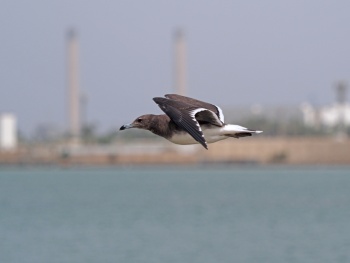- Ichthyaetus hemprichii
Larus hemprichii
Identification
Length 43–48 cm (17-19 in), wingspan 105–118 cm, weight 400–510 g
Adult: Blackish-brown hood with faint, narrow white eye crescents in breeding plumage, black upper throat, and neck-sides, bordered below by a narrow white bar. Dark chocolate-brown upperparts and inner upperwings, paler brown upper breast, white underparts. Black primaries, black secondaries with a narrow white trailing edge, dark underwing; tail white. Bill long and stout, dull yellowish with a narrow black band and red tip; legs dull yellow. Adults in non-breeding plumage are similar, but the hood is paler brown and flecked white small white spots.
Juvenile: uniform pale brown head, neck and breast, brown, broadly pale-fringed, feathers to upperparts and upperwings, black band on end of tail. Bill pale bluish-grey with a black tip. Greyer feathering on their head, breast and upperparts appear during the first winter; second-winter plumage is closer to that of the adult, but lacking the hood. Adult plumage is acquired at two to three years of age.
Similar Species
White-eyed Gull is closely related and occurs in much the same area; it differs in being smaller and slenderer, and greyer above; it has a strikingly slender red bill with a small black tip (all-black in immatures).
Distribution
Pakistan to Kenya including the Red Sea and (unlike White-eyed Gull) the Persian Gulf.
Rarer than White-eyed Gull in the far north of the Red Sea, only a vagrant at Eilat in Israel and Aqaba in Jordan; vagrants also recorded in Lebanon, India, Sri Lanka, the Maldives, and inland in Kenya at Lake Rudolf.
Taxonomy
This is a monotypic species[1].
Like the other species in its genus, it was formerly included in the genus Larus.
Habitat
Inshore islands with rocks and sandy beaches.
Behaviour
Like other medium-large gulls; often aggressive and piratical, and a major predator on other seabirds in the region.
Diet
They are scavengers, mainly eating dead fish and offal. They will also take tern eggs and chicks, as well as turtle hatchlings. They are also predators and will attack other seabirds, including cormorants.
Breeding
The lay 1-3 eggs in a shallow depression, which is lined with a little vegetation. Incubation takes about 25 days.
References
- Clements, J. F., T. S. Schulenberg, M. J. Iliff, S. M. Billerman, T. A. Fredericks, B. L. Sullivan, and C. L. Wood. 2019. The eBird/Clements Checklist of Birds of the World: v2019. Downloaded from http://www.birds.cornell.edu/clementschecklist/download/
- Burger, J., M. Gochfeld, G. M. Kirwan, and E. F. J. Garcia (2020). Sooty Gull (Ichthyaetus hemprichii), version 1.0. In Birds of the World (J. del Hoyo, A. Elliott, J. Sargatal, D. A. Christie, and E. de Juana, Editors). Cornell Lab of Ornithology, Ithaca, NY, USA. https://doi.org/10.2173/bow.soogul2.01
Recommended Citation
- BirdForum Opus contributors. (2025) Sooty Gull. In: BirdForum, the forum for wild birds and birding. Retrieved 11 May 2025 from https://www.birdforum.net/opus/Sooty_Gull
External Links
GSearch checked for 2020 platform.!







